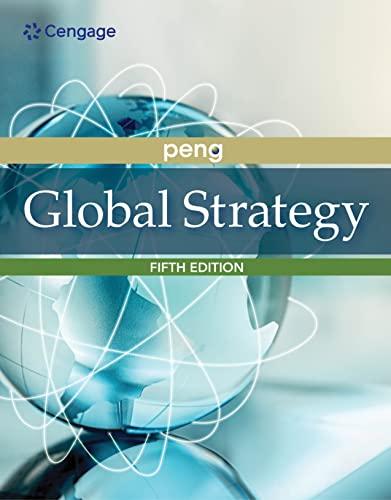Founded in 2003 and based in Abu Dhabi, Etihad Airways is both inspired by Emirates Airlines and
Question:
Founded in 2003 and based in Abu Dhabi, Etihad Airways is both inspired by Emirates Airlines and a direct competitor of Emirates, which is based in Dubai, a fellow emirate in the United Arab Emirates (UAE). Etihad, which means “union” in Arabic, has quickly become the fastest-growing airline in the history of commercial aviation. With more than 100 aircraft, Etihad flies 11 million passengers to nearly 100 destinations around the world. Now the fourth-largest airline in the world, Emirates is a mammoth with 220 aircraft that carry 40 million passengers to more than 100 cities.
Etihad imitates the highly successful Emirates by
(1) equipping itself with modern long-haul jets (such as Airbus A380 and Boeing 777 Extended Range [ER])
(2) leveraging the enviable location of the Abu Dhabi International Airport, which is only an hour away by car from Dubai’s storied airport.
Given the small local population (three million in Abu Dhabi vis-à-vis four million in Dubai), Etihad—like Emirates—can only grow by being a “superconnector” airline. In other words, most of the passengers travel neither from nor to Abu Dhabi. Blessed by its Middle East location, Abu Dhabi, just like Dubai, is an ideal stopping point for air traffic between Europe and Australasia and between Asia and Africa.
One area that Etihad has decisively deviated from its role model Emirates is an interest in weaving an alliance network.
Other than a single alliance with Qantas, Emirates either has been very shy or does not care about collaboration. In an industry with three major multipartner networks—One World, Sky Team, and Star Alliance—airlines are no strangers to alliances. But Etihad’s alliances are unique. Its talks to join these three mega networks did not go anywhere, because none of them was interested in admitting an ambitious new member determined to eat their lunch. Frustrated, Etihad built its own alliance network consisting of eight smaller airlines, in which it made a series of equity-based strategic investments.
In 2011, Etihad took a 29% equity in Air Berlin, Europe’s sixth-largest airline at that time. Since then, Etihad acquired stakes in the following airlines:
● Aer Lingus based in Dublin, Ireland (4% equity);
● Alitalia based in Rome, Italy (49%), the largest airline in Italy;
● Air Serbia based in Belgrade, Serbia (49%), the largest airline in Serbia, formerly known as Jat Airways;
● Air Seychelles based in Mahe, Seychelles (40%);
● Darwin Airline based in Lugano, Switzerland (34%), which was recently rebranded as Etihad Regional;
● Jet Airways based in Mumbai, India (24%); and
● Virgin Australia based in Brisbane, Australia (20%).
Etihad CEO James Hogan, who is an Australian, is viewed as a “white knight” who bailed out a bunch of money-losing or cash-poor airlines, including the struggling flag carriers of Ireland, Italy, Serbia, and Seychelles. Hogan has argued that his multibillion-dollar investments in airlines that serve smaller markets made economic sense by increasing Etihad’s passenger tally and securing economies of scale when competing with Emirates. But can Etihad turn such an alliance network profitable? The most challenging member is Alitalia, which lost $1.5 billion in five years, and Etihad spent $760 million to breathe new life into it.
Always known for using nasty language, Michael O’Leary, CEO of Ireland’s and Europe’s largest airline Ryanair, bluntly told journalists that Etihad “bought a lot of rubbish, and increasing their stake in Aer Lingus is consistent with that.” Indeed, no other airline in the world is doing what Etihad is doing at this scale. Does Etihad, despite its deep pockets, have what it takes to turn around a whole bunch of also-rans?
In 2017, with mounting losses at Air Berlin, Etihad stopped financial support. Totally bankrupt, Air Berlin entered insolvency procedures and ceased operations in 2017.
The biggest headache is Alitalia, from which Etihad also pulled the plug in 2017. Then Alitalia entered into bankruptcy but kept flying. In the onslaught of the coronavirus in 2020, air travel was dramatically reduced. Alitalia collapsed, and the Italian government—having failed to find a buyer since 2017—in March 2020 took full control of it, turning it into a state-owned enterprise but keeping it flying. Can Etihad, which is struggling itself, afford to keep its other junior partners flying?
Case Discussion Questions
1. From the perspective of Etihad, what are the pros and cons of its alliance network?
2. Why was Etihad’s application to join the three major multipartner alliance networks rejected?
3. In the post coronavirus environment, can Etihad, which is struggling itself, afford to keep its junior partners flying?
Step by Step Answer:






